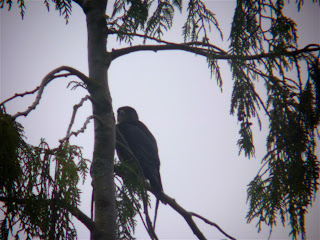Over the past two years, volunteering with the Merlin Falcon Foundation, I've had at least 50 people ask me about that 'Merlin' or 'falcon' or 'little hawk' that was hunting birds in their garden or near their bird feeders. Most often, when people thought they were seeing a Merlin (falcon), they were actually seeing a juvenile Sharp-Shinned Hawk, or sometimes a juvenile Cooper's Hawk, trying to get an easy meal. I recently painted the picture, above, to show the differences between the Coastal Forest Merlin (Falco columbarius suckleyi) and the Sharpies.
Merlins, by Audubon
Look first at the eyes. The Merlin's eyes are a dark, chocolate brown, surrounded by a yellow orbital circle and a light brow. The Sharp-Shinned Hawk's eyes are a pale yellow when young, becoming more orange and reddish as an adult. Now look at the breast and belly. Our resident Merlins are darkly streaked while the juvenile Sharpies are lightly streaked and the adults are reddish-barred. Look now at the tail. The Sharp-Shinned Hawks have longer tail feathers with easy to see black bars.
You will likely hear a Merlin before you see it. If they are calling to their mate or fledged young or chasing off a large predator like a Bald Eagle, you will hear a fierce sounding Kee-Kee-Kee-Kee. Look up quick above the tree canopy and you may see the avian equivalent to a jet plane.
female Merlin waiting for the male to bring food
female eating food brought by male
female doing post-copulation preening
male watching over nest sight from a safe distance
post-fledging juveniles waiting for parent prey delivery
I believe in non-invasive field studies, where the birds can carry out their migratory, mating, and breeding activities without interference. That's why I got involved in the 25 year long field study being conducted by the Merlin Falcon Foundation. Check out their website, if you want to learn more of their life activities or hear vocalizations or get involved yourself.
When I first moved to this bioregion seven years ago, the birds and the forest flora were as unintelligible to me as a partly learned foreign language. I was familiar with chaparral and oak forest ecology, found in regions South. With time and patience, you can learn the 'language' of your local ecosystem. You can learn to read nature and you can share those insights with others. In the next posting of this blog, I will give some hints on keeping a field journal and I'll highlight another regional bird species.







